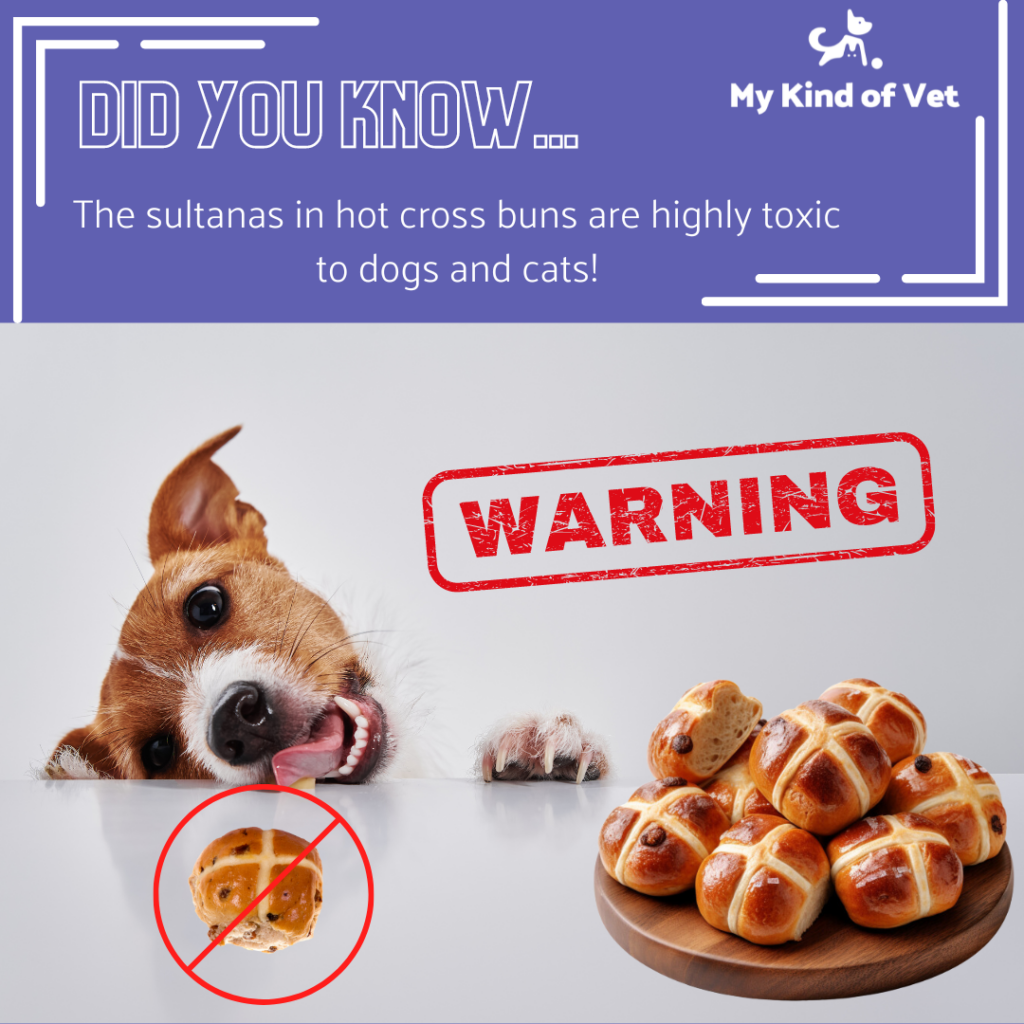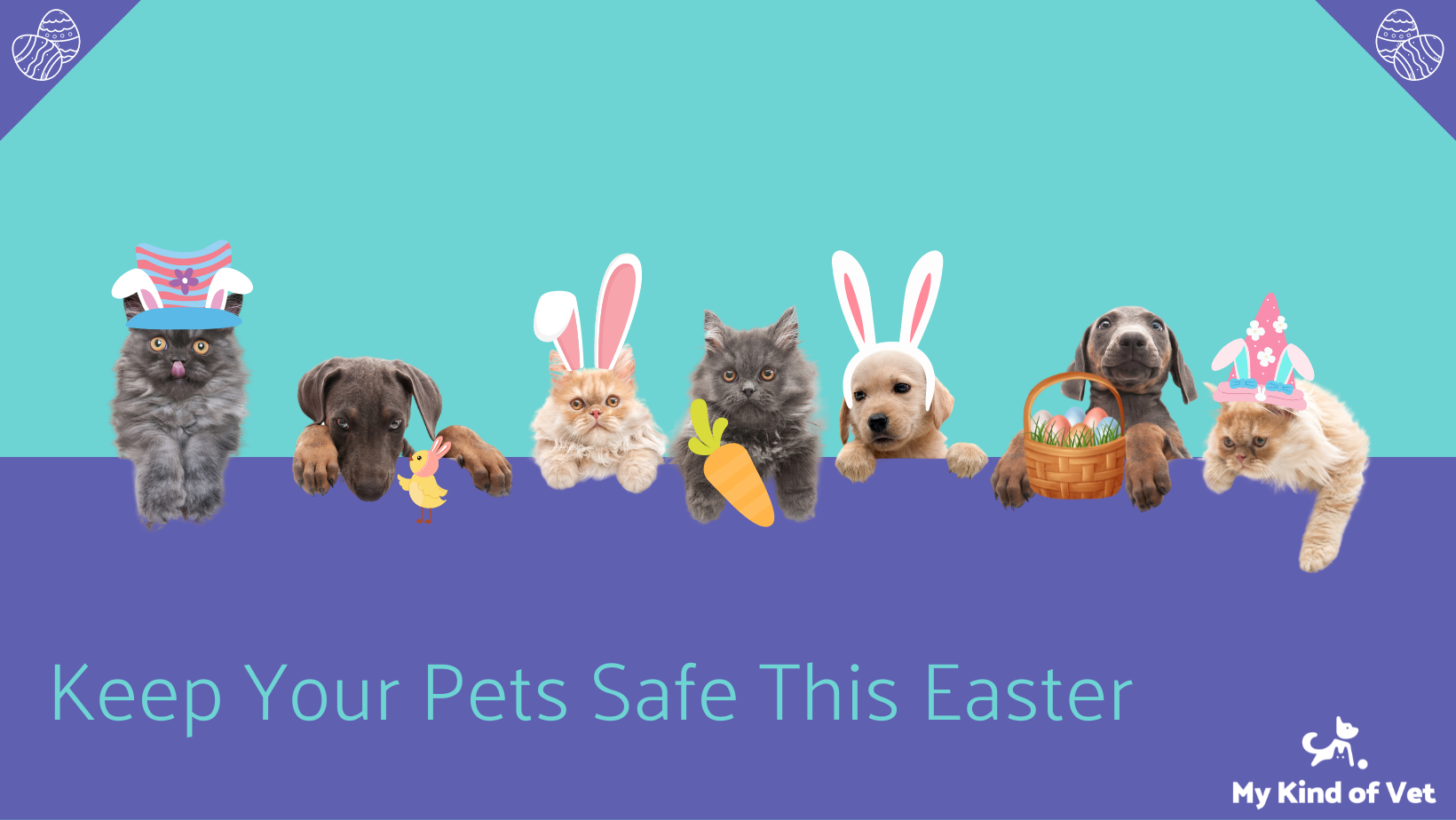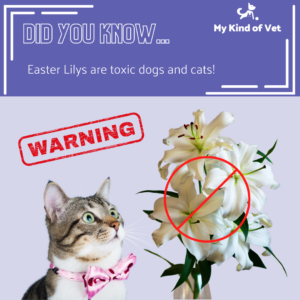Easter for some people can be a lovely time filled with chocolate and family fun! But did you know that this holiday poses quite a few dangers to your beloved family pets?
Read on to learn how to protect your pets and to help avoid expensive emergency vet trips over the break.

Hot Cross Buns:
Thinking of sharing that last bite of your tasty hot cross bun with your pet? Please don’t! They may seem like a perfectly harmless treat, but did you know that grapes, sultanas, currents and raisins can all cause kidney injury in dogs and cats? The mechanism of toxicity was previously unclear but it now thought to be related to tartaric acid, a compound found in high concentrations in grapes. Even a small amount can cause:
- Vomiting
- Diarrhoea
- Poor appetite
- Lethargy
- Abdominal pain
- Inability to product urine
- Kidney Failure
- Worst cases: Death
Chocolate:
While there are many human foods that can be safely fed to our four legged friends in small doses, chocolate unfortunately is not one of them. If your dog or cat has eaten chocolate you are strongly advised to contact your local vet immediately for medical advice.
Chocolate is toxic to dogs. Chocolate ingestion can result in vomiting, diarrhoea or even seizures. In severe cases chocolate toxicity can be fatal.
How much chocolate is toxic for my dog?
The effect of your dog eating chocolate is determined by a few main factors:
- How much your dog weighs
- How much chocolate your dog ate
- What type of chocolate your dog ate (dark, white or milk)
There is a chemical in chocolate called theobromine, which is similar to caffeine, and is highly poisonous to dogs.
Different types of chocolate contain different amounts of theobromine, however the general rule is that the more bitter the chocolate, the higher the toxicity to your dog.
As a rough guide:
- White chocolate has the least at around 0.25 mg per 28 grams of chocolate
- Milk chocolate contains 44–58 mg per 28 grams of chocolate
- Dark chocolate contains between 130–450 mg per 28 grams of chocolate
What are the symptoms of chocolate poisoning?
Symptoms of chocolate toxicity can take several hours to show, and even longer to disappear. Some signs that your dog may have eaten chocolate are:
- Vomiting
- Diarrhoea
- Increased thirst
- Excessive urination
- Faster than normal heartbeat
- Muscle spasms
- Organ Failure
- Seizures
High doses of chocolate ingested can result in cardiac arrest. The heart fails to pump blood effectively and can lead to sudden death or permanent internal damage if not provided with immediate emergency medical attention.
How is chocolate poisoning treated?
Treatments can vary depending on the amount of chocolate that your dog has eaten however the first step if treated early is to induce vomiting, and try to block absorption of the theobromine before it is absorbed into your dogs body.
Depending on the severity of the poisoning, it may be necessary to administer IV fluids to help flush out your pets system.
Easter Lily
Unbeknownst to many pet owners, Easter lilies are highly toxic to cats. All parts of the Easter lily plant are poisonous – the petals, the leaves, the stem and even the pollen. Cats that ingest as few as one or two leaves, or even a small amount of pollen while grooming their fur, can suffer severe kidney failure.
In most situations, symptoms of poisoning will develop within six to 12 hours of exposure. Early signs include vomiting, loss of appetite, lethargy and dehydration. Symptoms worsen as kidney failure develops. Some cats will experience disorientation, staggering and seizures.
There is no effective antidote to counteract lily poisoning, so the sooner you can get your cat to the veterinarian, the better their chances of survival will be. If you see your cat licking, eating or even sniffing any part of an Easter lily, call your veterinarian or go to an emergency vet clinic immediately.
Although not as toxic to dogs, eating the Easter Lily can still make dogs ill, causing gastrointestinal upset; vomiting and diarrhoea.
There are several other types of lilies that are toxic to cats as well. They are of the Lilium and Hemerocallis species and commonly referred to as Tiger lilies, Day lilies and Asiatic lilies. Popular in many gardens and yards, they can also result in severe acute kidney failure. These lilies are commonly found in florist bouquets, so it is imperative to check for poisonous flowers before bringing bouquets into the household.

Toys, Wrappers and Plastics
Be mindful of small toys which are often found in children’s Easter eggs and plastic eggs, both of which could be a choking hazard for pets. Even Easter plushies can have hard plastic eyes or small parts attached that can be a choking hazard to pets.
If you are planning to hide plastic or chocolate eggs outside, make sure to keep your pet inside until they have all been found, (count how many you hide and ensure they have all been accounted for at the end of the game) and keep any small toys well out of reach.
For toys, plastics and even chocolate wrappers; they not only pose the threat of choking. These items are also a gastrointestinal blockage hazard. An item being stuck inside your pet and causing a blockage is an urgent emergency, often requiring life saving (and often expensive) surgery. Supervise your pets and keep possible hazards out of reach.

Kids and Pets; Lets Keep Everyone Safe
Easter can mean that the kids are on school holidays and spending more time at home, or the long weekend can often bring friends’ and family members’ children visiting. It is very important to ensure that both your pets and any children (either your own, or visitors) stay safe and happy.
Discuss with your children, or visiting parents and children about the importance of safety around pets. Some important points to go through may include:
- Always asking permission before petting an animal that isn’t yours
- Being gentle and never grabbing or pulling on a pet. Never jump on pets, or ride on dogs
- Let pets come to you, and when they pull to get away, always let them go and give them space
- Do not go near an eating dog or startle a sleeping dog. And do not engage with a pet that is in their safe space, such as their bed, or crate- it is very important for pets to know they have a safe space to go where they will be left alone
- Explain things that may be dangerous to your pet, such as sharing dangerous food with them, or leaving toys out that they ingest
Always have adult supervision when pets and children are together, and always provide a safe space for your pet so it may leave and retreat from the situation if it becomes scared or nervous, or has had enough.
Unfortunately roughly 89% of dog bites to children occur with a dog that is known to the child. Over 50% of instances documented could have been avoided by better educating children on safe behaviour around dogs and allowing dogs to leave to their own space when they want. Even the most docile, sweet tempered, “would never hurt a fly” dog can bite when pushed outside of their comfort zone. One poke in the wrong spot, grab of a tail, or kiss on the face too many and any dog has the potential to snap.
While supervising look out for the following warning signs from your dog:
- Licking their lips
- Intent focused stare at the child
- Showing the whites of their eyes
- Looking away or trying to move or pull away
- Growl, snarl, or raising of their lip
- Even appeasing signs like licking your child or rolling on their belly can be warning signs of your dog being uncomfortable- seek the advise of a vet professional or animal behaviourist if you are unsure if behaviour is comfortable or uncomfortable.
If your pet shows any of the above signs, separate your child and pet immediately and give them a break apart.
The bond between a child and pet can be an absolutely beautiful thing! Just make sure to educate, keep a close eye, and keep everybody safe!




